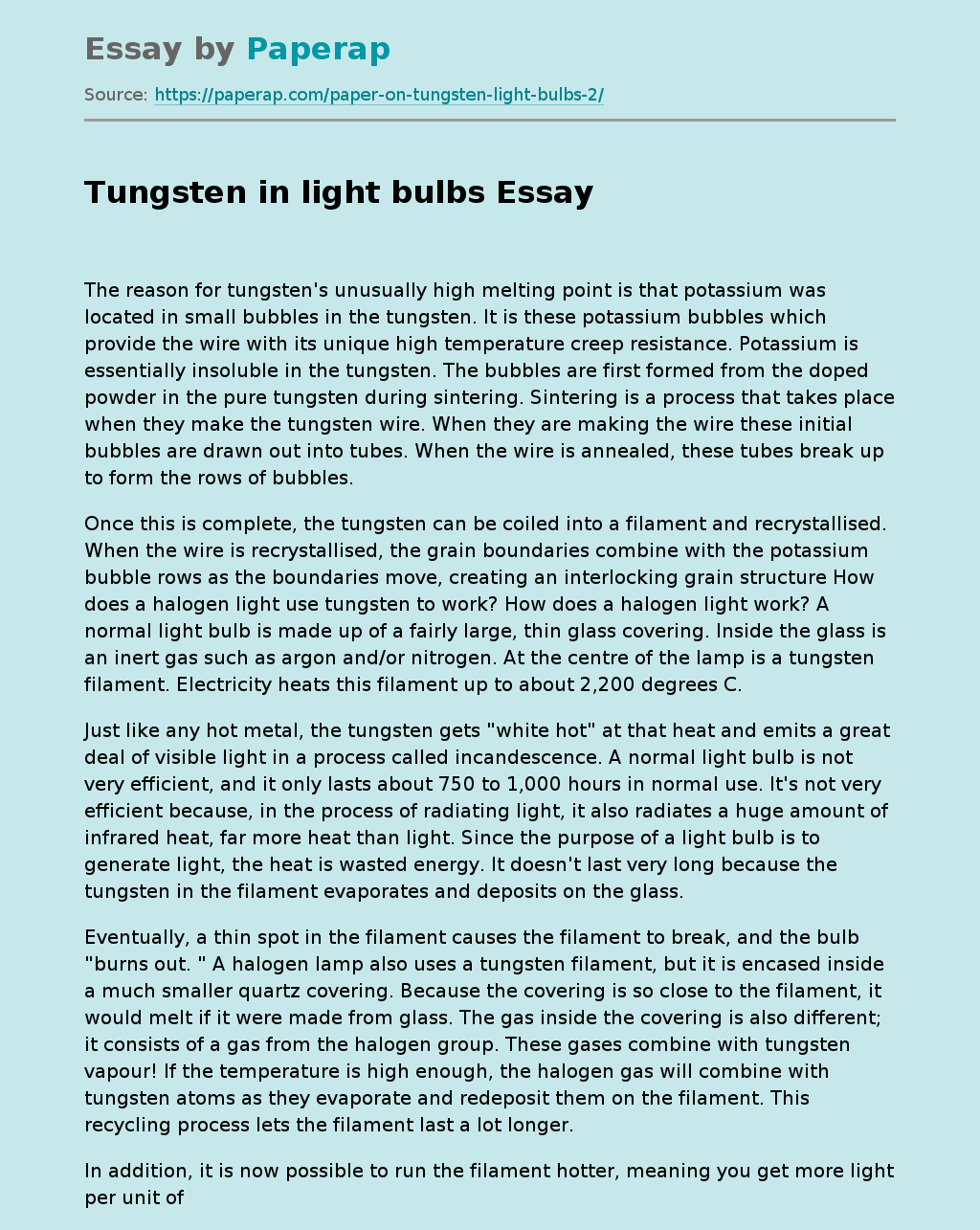The reason for tungsten’s unusually high melting point is that potassium was located in small bubbles in the tungsten. It is these potassium bubbles which provide the wire with its unique high temperature creep resistance. Potassium is essentially insoluble in the tungsten. The bubbles are first formed from the doped powder in the pure tungsten during sintering. Sintering is a process that takes place when they make the tungsten wire. When they are making the wire these initial bubbles are drawn out into tubes.
When the wire is annealed, these tubes break up to form the rows of bubbles.
Once this is complete, the tungsten can be coiled into a filament and recrystallised. When the wire is recrystallised, the grain boundaries combine with the potassium bubble rows as the boundaries move, creating an interlocking grain structure How does a halogen light use tungsten to work? How does a halogen light work? A normal light bulb is made up of a fairly large, thin glass covering.
Inside the glass is an inert gas such as argon and/or nitrogen. At the centre of the lamp is a tungsten filament. Electricity heats this filament up to about 2,200 degrees C.
Just like any hot metal, the tungsten gets “white hot” at that heat and emits a great deal of visible light in a process called incandescence. A normal light bulb is not very efficient, and it only lasts about 750 to 1,000 hours in normal use. It’s not very efficient because, in the process of radiating light, it also radiates a huge amount of infrared heat, far more heat than light.
Since the purpose of a light bulb is to generate light, the heat is wasted energy. It doesn’t last very long because the tungsten in the filament evaporates and deposits on the glass.
Eventually, a thin spot in the filament causes the filament to break, and the bulb “burns out. ” A halogen lamp also uses a tungsten filament, but it is encased inside a much smaller quartz covering. Because the covering is so close to the filament, it would melt if it were made from glass. The gas inside the covering is also different; it consists of a gas from the halogen group. These gases combine with tungsten vapour! If the temperature is high enough, the halogen gas will combine with tungsten atoms as they evaporate and redeposit them on the filament. This recycling process lets the filament last a lot longer.
In addition, it is now possible to run the filament hotter, meaning you get more light per unit of energy. You still get a lot of heat, and because the quartz covering is so close to the filament, it is much hotter then a normal light bulb. These bulbs are only about 15% more efficient than standard incandescents. Properties of tungsten How is tungsten made? There are two major minerals in tungsten. The first is wolframite [(Fe, Mn)WO4], which contains iron and manganese. The second is Scheelite (CaWO4), which makes a bright bluish colour under ultraviolet light.
After grinding and cleaning, the ores are treated with alkalis to yield tungsten trioxide (WO3). The trioxide is finally reduced with carbon or hydrogen gas to produce the pure metal. Main properties of tungsten Tungsten has many unique properties that contribute to its outstanding performance as an electrical contact. It has a melting point of 3410i?? C, boiling point of 5660i?? C, high density, and links electrical and thermal conductivity. These properties provide it with excellent resistance to sticking or welding, and outstanding resistance to metal transfer and electrical erosion. Tungsten is a steel-grey to tin-white metal.
Impure tungsten metal is quite brittle, although pure tungsten can be cut with a saw, spun, drawn, forged, and extruded. Tungsten has the highest melting point and the lowest vapour pressure of the metals. At temperatures exceeding 1650i?? C, it has the highest tensile strength. Tungsten oxidizes in air at high temperatures. Because of its high temperature strength, tungsten is used in a number of applications where the temperature is as high as 4500i?? F. Unfortunately, tungsten is not an inert metal, and reacts with certain gases and other materials unless adequate precautions are observed.
Air: Above 950i?? F tungsten reacts with the oxygen in air forming a volatile oxide coating on the surface. This is a surface reaction which, while causing wastage of the tungsten, does it no internal structural harm. Above 2200i?? F, there is a strong evaporation of the oxide formation. Obviously tungsten should not be used in air above 950i?? F except for very short duration. Hydrogen, Nitrogen, Ammonia and Inert Gases: For all practical purposes, tungsten is stable with all these gases up to its melting point.
Water Vapour: Tungsten can tolerate water vapour at all temperatures. Carbon Dioxide & Monoxide: Above 2500i?? F, carbon dioxide oxidizes tungsten. Above 1450i?? F, carbon monoxide reacts with tungsten to form its carbide. Carbon & Hydrocarbons: Tungsten reacts with graphite and other carbon forms above 2550i?? F to form tungsten carbide. Molten Metals: Tungsten exhibits good resistance to attack from many molten metals including mercury, gallium, sodium, potassium, NAK, magnesium, bismuth and zinc.
Tungsten is attacked by molten aluminium; however, the rate of attack is much less than with other metals. Atomic Number 74 Atomic Weight 183. 86 Maximum Density at 20i?? C (68i?? F) 19. 3 g Melting Point 3410i?? C (6170i?? F) Thermal Conductivity at 20i?? C 0. 40 cal/cm/i?? C/sec Electrical Conductivity 31% IACS Tensile Strength at Room Temp. 100,000 – 500,000 psi Tensile Strength at 500i?? C (932i?? F) 75,000 – 194,000 psi Tensile Strength at 1000i?? C (1832i?? F) 50,000 – 75,000 psi Shell structure of tungsten.
Tungsten in light bulbs. (2017, Dec 17). Retrieved from https://paperap.com/paper-on-tungsten-light-bulbs-2/

